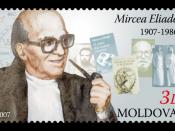Source: Eliade, Mircea. The Encyclopedia of Religion: Volume 3. New York: Macmillan Publishing Company.
The symbolism of the center of the world appears in several cultures throughout time. Literally, the center of the world refers to the core of the earth. However, in cultural and religious contexts the term refers to the place where all planes of reality intersect, including heaven and underground realms. At this point communication and even passage among the planes is possible. Civilizations throughout the world consider the center of the world to be a sacred place and thus perform rituals such as consecration and sacrifice. Therefore, it is also heavily associated with the passage of birth and death. Furthermore, the center of the world has multiple forms. It can exist within a tree, on top of a mountain, or in the center of a village. For example, Mount Tabur translates in its native language to mean the naval of the earth.
The center of the world can be designated in one of two ways: either by the appearance of a supernatural power or god, or through acts of deliberate consecration carried on by human beings. In each case, the sacred place is considered apart from the rest of the world, either spiritually or physically. Although the physical journey to it may not be an arduous one, the spiritual voyage may be fraught with danger and require careful preparation. The spiritual strength that this passage entails is rewarded with a transcendence that enables the traveler to ascend to a greater realm of consciousness and knowledge beyond the reach of humanity. In fact, in the sacrifice of the Vedic people, the human sacrifice believes wholeheartedly that by giving their physical body to the gods and dying upon a cosmic pillar, the embodiment of the center...



Symbolism in the center of the world
The essay topic and what information is there is good, but it doesn't really go indepth enough.
4 out of 5 people found this comment useful.